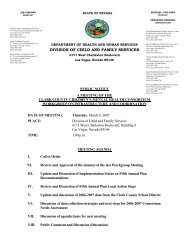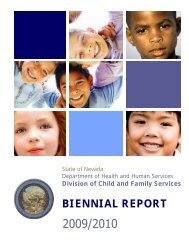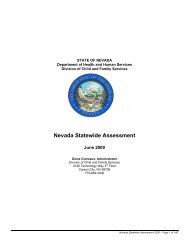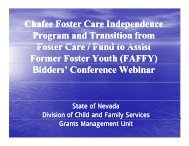STATE OF NEVADA - Division of Child and Family Services
STATE OF NEVADA - Division of Child and Family Services
STATE OF NEVADA - Division of Child and Family Services
Create successful ePaper yourself
Turn your PDF publications into a flip-book with our unique Google optimized e-Paper software.
District provides services to Carson City, the State’s Capitol, Douglas County, Storey County, <strong>and</strong> a portion <strong>of</strong> Lyon<br />
County. District 3 covers the eastern/central part <strong>of</strong> the state <strong>and</strong> is based out <strong>of</strong> Fallon. This <strong>of</strong>fice provides services to<br />
Churchill, Lyon, Pershing <strong>and</strong> Mineral Counties. District 4 covers the southern rural part <strong>of</strong> the state <strong>and</strong> is based out <strong>of</strong><br />
Pahrump. This <strong>of</strong>fice provides services to Esmeralda <strong>and</strong> Nye Counties. For the most part, growth in Nevada’s rural<br />
counties has been fairly stable. Elko has seen substantial growth in the past few years.<br />
Staff <strong>and</strong> Work Load:<br />
There are currently 490 caseworker <strong>and</strong> 121 supervisory/management positions in child welfare filled statewide. There is<br />
currently an 8.2% vacancy rate statewide for all child welfare caseworker <strong>and</strong> supervisory/management positions.<br />
Clark County Department <strong>of</strong> <strong>Family</strong> <strong>Services</strong>: CCDFS currently has 335 caseworker <strong>and</strong> 80 supervisory/management<br />
positions filled <strong>and</strong> 20 vacancies. CCDFS has a current case load ratio <strong>of</strong> approximately 1 worker to 15.7 cases for child<br />
protective services; 26.6 children per worker for permanency out-<strong>of</strong>-home workers <strong>and</strong> 24.6 children per worker for<br />
permanency in-home workers.<br />
Washoe County Department <strong>of</strong> Social <strong>Services</strong>: WCDSS currently has 94 caseworker (case manager) <strong>and</strong> 25<br />
supervisory/management positions filled <strong>and</strong> 19 vacancies (17 vacant caseworker <strong>and</strong> 2 vacant supervisory/management<br />
positions). The turnover rate for WCDSS case workers for SFY 09 was 12.12%. This is a 4.55% decrease from the<br />
previous fiscal year. Exit interviews were initiated this current year to analyze trends in staff turnover with the most<br />
common characteristic being job dem<strong>and</strong>s <strong>and</strong> timeframes. WCDSS has a current case load ratio <strong>of</strong> approximately 1<br />
worker to 25 children for ongoing services <strong>and</strong> 1 worker to 12 cases for assessment workers.<br />
DCFS – Rural Region: DCFS currently has 61 case worker (Social Worker II/III) positions filled, 49 <strong>of</strong> which are in the<br />
CPS/Substitute care area <strong>and</strong> the remainder in adoption <strong>and</strong> ICPC (5), adoption recruitment (1), quality assurance - QA<br />
(2) <strong>and</strong> licensing (4). There are four district <strong>of</strong>fice manager positions filled, nine Social Work Supervisors for CPS <strong>and</strong><br />
Substitute Care <strong>and</strong> three for QA, Adoption <strong>and</strong> Licensing. Four <strong>of</strong> the above supervisors are new during the past fiscal<br />
year. There are currently five caseworker vacancies in the Rural Region, including four in CPS/Substitute Care <strong>and</strong> one<br />
in QA. In the past fiscal year, 13 staff either retired or were terminated <strong>and</strong> 17 new staff were hired. There has been a<br />
50% decrease in vacancies in the rural region from July 2009 (10 vacancies) to April 2010 (5 vacancies). The DCFS<br />
Rural Region has a current caseload size <strong>of</strong> 15-18 cases for each CPS worker <strong>and</strong> 16 – 18 cases for substitute care<br />
workers.<br />
<strong>Child</strong>ren in Care in Nevada<br />
For the State Fiscal Year period <strong>of</strong> July 1, 2009 through May 31, 2010; Nevada had a total <strong>of</strong> 7,921 children in care.<br />
Table 01 shows a variety <strong>of</strong> information on how many children are currently in care; how many entered <strong>and</strong> left care<br />
during the year long period <strong>and</strong> how many had previous exposure to the foster care system. Compared to SFY 2009 data<br />
for the same time period (July 1 – May 31); there were a total <strong>of</strong> 7730 children in care during the fiscal year. Nevada has<br />
shown a 5.68% decrease in the number <strong>of</strong> children in care from this fiscal year to last fiscal year.<br />
Table 01: Foster Care Summary Information<br />
Summary Total Rural Washoe Clark<br />
Total during this current time frame 7291 605 1336 5350<br />
Total Entering 2461 218 481 1762<br />
Entered with less than 2 placements in first year 2120 189 415 1516<br />
Total with prior Foster Care Experience 20 1 6 13<br />
Total Leaving Care During this time frame 2481 189 508 1784<br />
Source: UNITY Report CFS721 for July 1, 2009 – May 31, 2010.<br />
The majority <strong>of</strong> children entering care are birth to five years <strong>of</strong> age (50.9%); with an average <strong>of</strong> 1.55 placements. Youth<br />
age 15 to 19 years were the smallest group entering care (7.23%), but this group had the highest average number <strong>of</strong><br />
placements (2.12) Table 02 shows the breakdown <strong>of</strong> children in care during SFY 2010 <strong>and</strong> includes a breakdown <strong>of</strong> the<br />
ages <strong>of</strong> the children entering <strong>and</strong> leaving care during the year.<br />
Nevada APSR – SFY 2010<br />
Page 9 <strong>of</strong> 108
















